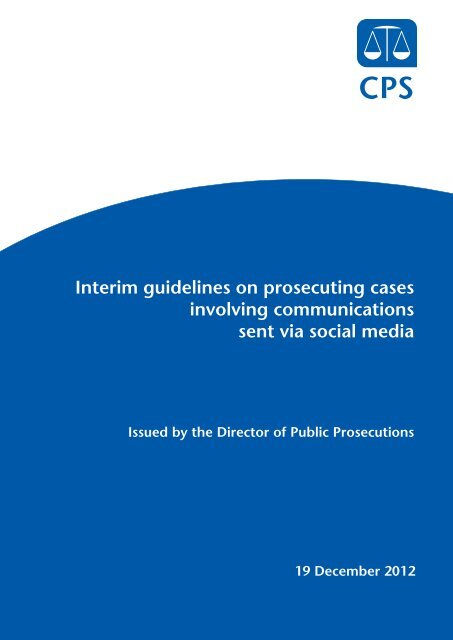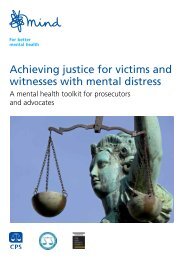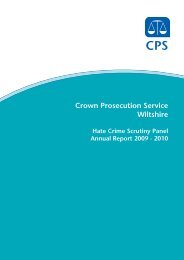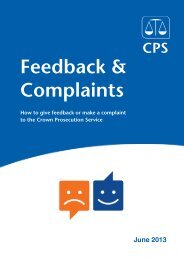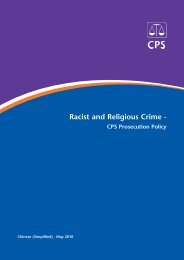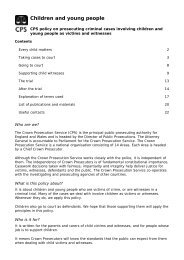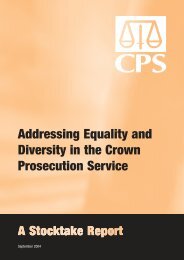Interim guidelines - Crown Prosecution Service
Interim guidelines - Crown Prosecution Service
Interim guidelines - Crown Prosecution Service
Create successful ePaper yourself
Turn your PDF publications into a flip-book with our unique Google optimized e-Paper software.
<strong>Interim</strong> <strong>guidelines</strong> on prosecuting casesinvolving communicationssent via social mediaIssued by the Director of Public <strong>Prosecution</strong>s19 December 2012
<strong>Interim</strong> <strong>guidelines</strong> on prosecuting cases involvingcommunications sent via social mediaIssued by the Director of Public <strong>Prosecution</strong>s on 19 December 2012Introduction1. These <strong>guidelines</strong> set out the approach that prosecutors should take whenmaking decisions in relation to cases where it is alleged that criminaloffences have been committed by the sending of a communication viasocial media. The <strong>guidelines</strong> are designed to give clear advice toprosecutors who have been asked either for a charging decision or forearly advice to the police, as well as in reviewing those cases which havebeen charged by the police. Adherence to these <strong>guidelines</strong> will ensure thatthere is a consistency of approach across the CPS.2. The <strong>guidelines</strong> cover the offences that are likely to be most commonlycommitted by the sending of communications via social media. These<strong>guidelines</strong> equally apply to the resending (or retweeting) ofcommunications and whenever they refer to the sending of acommunication, the <strong>guidelines</strong> should also be read as applying to theresending of a communication. However, for the reasons set out below,the context in which any communication is sent will be highly material.3. These <strong>guidelines</strong> are primarily concerned with offences that may becommitted by reason of the nature or content of a communication sent viasocial media. Where social media is simply used to facilitate some othersubstantive offence, prosecutors should proceed under the substantiveoffence in question.1
10. In the majority of cases, prosecutors should only decide whether toprosecute after the investigation has been completed. However, there willbe cases occasionally where it is clear, prior to the collection andconsideration of all the likely evidence, that the public interest does notrequire a prosecution. In these cases, prosecutors may decide that thecase should not proceed further.11. Cases involving the sending of communications via social media are likelyto benefit from early consultation between police and prosecutors, and thepolice are encouraged to contact the CPS at an early stage of theinvestigation.Initial assessment12. Communications sent via social media are capable of amounting tocriminal offences and prosecutors should make an initial assessment ofthe content of the communication and the course of conduct in question soas to distinguish between:(1) Communications which may constitute credible threats of violenceto the person or damage to property.(2) Communications which specifically target an individual orindividuals and which may constitute harassment or stalking withinthe meaning of the Protection from Harassment Act 1997 or whichmay constitute other offences, such as blackmail.(3) Communications which may amount to a breach of a court order.This can include offences under the Contempt of Court Act 1981 orsection 5 of the Sexual Offences (Amendment) Act 1992. All suchcases should be referred to the Attorney General, and via thePrincipal Legal Advisor’s team where necessary.3
(4) Communications which do not fall into any of the categories aboveand fall to be considered separately (see below): i.e. those whichmay be considered grossly offensive, indecent, obscene orfalse.13. As a general approach, cases falling within paragraphs 12 (1), (2) or (3)should be prosecuted robustly where they satisfy the test set out in theCode for <strong>Crown</strong> Prosecutors. Whereas cases which fall within paragraph12(4) will be subject to a high threshold and in many cases a prosecutionis unlikely to be in the public interest.14. Having identified which of the categories set out in paragraph 12 thecommunication and the course of conduct in question falls into,prosecutors should follow the approach set out under the relevant headingbelow.(1) Credible threats15. Communications which may constitute credible threats of violence to theperson may fall to be considered under section 16 of the Offences Againstthe Person Act 1861 if the threat is a threat to kill within the meaning ofthat provision.16. Other credible threats of violence to the person may fall to be consideredunder section 4 of the Protection from Harassment Act 1997 if theyamount to a course of conduct within the meaning of that provision andthere is sufficient evidence to establish the necessary state of knowledge.17. Credible threats of violence to the person or damage to property may alsofall to be considered under section 127 of the Communications Act 2003which prohibits the sending of messages of a “menacing character” bymeans of a public telecommunications network. However, beforeproceeding with a prosecution under section 127, prosecutors should heed4
the words of the Lord Chief Justice in Chambers v DPP [2012] EWH22157 (Admin) where he said:“… a message which does not create fear or apprehension in those towhom it is communicated, or may reasonably be expected to see it,falls outside [section 127(i)(a)], for the simple reason that the messagelacks menace.” (Paragraph 30)As a general rule, threats which are not credible should not be prosecuted,unless they form part of a campaign of harassment specifically targetingan individual within the meaning of the Protection from Harassment Act1997.18. Where there is evidence of discrimination, prosecutors should payparticular regard to the provisions of section 28-32 of the Crime andDisorder Act 1998 and section 145 of the Criminal Justice Act 2003(increase in sentences for racial and religious aggravation) and section146 of the Criminal Justice Act 2003 (increase in sentences foraggravation related to disability, sexual orientation or transgender identity).(2) Communications targeting specific individuals19. If communications sent via social media target a specific individual orindividuals, they will fall to be considered under the Protection fromHarassment Act 1997 where they amount to a course of conduct within themeaning of section 7 of that Act. In such cases, prosecutors should followthe CPS Legal Guidance on Stalking and Harassment.20. Where communications target a specific individual and the offence ofblackmail is made out, prosecutors should seek to prosecute thesubstantive offence.21. Again, where there is evidence of discrimination, prosecutors should payparticular regard to the provisions of section 28-32 of the Crime and5
Disorder Act 1998 and section 145 of the Criminal Justice Act 2003(increase in sentences for racial and religious aggravation) and section146 of the Criminal Justice Act 2003 (increase in sentences foraggravation related to disability, sexual orientation or transgender identity).(3) Breach of court orders22. Court orders can apply to those communicating via social media in thesame way as they apply to others. Accordingly, any communication viasocial media that may breach a court order falls to be considered underthe relevant legislation, including the Contempt of Court Act 1981 andsection 5 of the Sexual Offences (Amendment) Act 1992, which makes itan offence to publish material which may lead to the identification of avictim of a sexual offence.23. In such cases, prosecutors should follow the CPS Legal Guidance onContempt of Court and Reporting Restrictions and observe therequirement for contempt cases to be referred to the Attorney General,and via the Principal Legal Advisor’s team where necessary.(4) Communications which are grossly offensive, indecent, obscene orfalse.24. Communications which do not fit into any of the categories outlined abovefall to be considered either under section 1 of the MaliciousCommunications Act 1988 or under section 127 of the CommunicationsAct 2003. These provisions refer to communications which are grosslyoffensive, indecent, obscene, menacing or false (but as a general rule,menacing communications should be dealt with under the section aboveon credible threats).25. Section 1 of the Malicious Communications Act 1988 deals with thesending to another of an electronic communication which is indecent orgrossly offensive, or which conveys a threat, or which is false, provided6
there is an intention to cause distress or anxiety to the recipient. Theoffence is one of sending, delivering or transmitting, so there is no legalrequirement for the communication to reach the intended recipient. Theterms of section 1 were considered in Connolly v DPP [2007] 1 ALL ER1012 and “indecent or grossly offensive” were said to be ordinary Englishwords. A person guilty of an offence under section 1 of the MaliciousCommunications Act 1998 is liable, on summary conviction, toimprisonment for a term not exceeding six months or to a fine or both.26. Section 127 of the Communications Act 2003 makes it an offence to sendor cause to be sent through a “public electronic communications network“a message or other matter that is “grossly offensive” or of an “indecent,obscene or menacing character”. The same section also provides that it isan offence to send or cause to be sent a false message “for the purpose ofcausing annoyance, inconvenience or needless anxiety to another.” Thedefendant must be shown to have intended or be aware that the messagewas grossly offensive, indecent or menacing, which can be inferred fromthe terms of the message or from the defendant’s knowledge of the likelyrecipient. The offence is committed by sending the message. There is norequirement that any person sees the message or be offended by it.27. In Chambers v DPP [2012] EWHC 2157 (Admin), the Divisional Court heldthat because a message sent by Twitter is accessible to all who haveaccess to the internet, it is a message sent via a “public electroniccommunications network”. Since many communications sent via socialmedia are similarly accessible to all those who have access to the internet,the same applies to any such communications. However, section 127 ofthe Communications Act 2003 does not apply to anything done in thecourse of providing a programme service within the meaning of theBroadcasting Act 1990.7
Context and approach28. Every day many millions of communications are sent via social media andthe application of section 1 of the Malicious Communications Act 1988 andsection 127 of the Communications Act 2003 to any that are grosslyoffensive, indecent, obscene or menacing or that are false if there is anintention to cause annoyance, inconvenience or needless anxiety toanother, creates the potential that a very large number of cases could beprosecuted before the courts. Taking together, for example, Facebook,Twitter, LinkedIn and YouTube, there are likely to be hundreds of millionsof communications every month.29. In these circumstances there is the potential for a chilling effect on freespeech and prosecutors should exercise considerable caution beforebringing charges under section 1 of the Malicious Communications Act1988 and section 127 of the Communications Act 2003. There is a highthreshold that must be met before criminal proceedings are brought andin many cases a prosecution is unlikely to be required in the publicinterest.1. Do you agree with the approach set out in paragraph 12 above to initiallyassessing offences which may have been committed using social media?The High Threshold30. Since both section 1 of the Malicious Communications Act 1988 andsection 127 of the Communications Act 2003 engage Article 10 of theEuropean Convention on Human Rights, prosecutors are reminded thatthese provisions must be interpreted consistently with the free speechprinciples in Article 10, which provide that: “Everyone has the right tofreedom of expression. This right shall include the freedom to hold8
opinions and to receive and impart information and ideas withoutinterference by public authority and regardless of frontiers …”31. As the European Court of Human Rights has made clear, Article 10protects not only speech which is well-received and popular, but alsospeech which is offensive, shocking or disturbing (Sunday Times v UK (No2) [1992] 14 EHRR 123):“Freedom of expression constitutes one of the essential foundations of ademocratic society…it is applicable not only to “information” or “ideas”that are favourably received or regarded as inoffensive or as a matter ofindifference, but also as to those that offend, shock or disturb …”32. Freedom of expression and the right to receive and impart information arenot absolute rights. They may be restricted but only where a restriction canbe shown to be both:Necessary andProportionate.These exceptions, however, must be narrowly interpreted and thenecessity for any restrictions convincingly established (see the judgment ofthe European Court in the Sunday Times case at paragraph 50)33. The common law takes a similar approach. In Chambers v DPP [2012]EWHC 2157 (Admin), the Lord Chief Justice made it clear that:“Satirical, or iconoclastic, or rude comment, the expression of unpopularor unfashionable opinion about serious or trivial matters, banter orhumour, even if distasteful to some or painful to those subjected to itshould and no doubt will continue at their customary level, quiteundiminished by [section 127 of the Communications Act 2003].”9
34. Prosecutors are reminded that what is prohibited under section 1 of theMalicious Communications Act 1988 and section 127 of theCommunications Act 2003 is the sending of a communication that isgrossly offensive. A communication sent has to be more than simplyoffensive to be contrary to the criminal law. Just because the contentexpressed in the communication is in bad taste, controversial orunpopular, and may cause offence to individuals or a specific community,this is not in itself sufficient reason to engage the criminal law. As LordBingham made clear in DPP v Collins [2006] UKHL 40:“There can be no yardstick of gross offensiveness otherwise than by theapplication of reasonably enlightened, but not perfectionist,contemporary standards to the particular message sent in its particularcontext”.35. Context is important and prosecutors should have regard to the fact thatthe context in which interactive social media dialogue takes place is quitedifferent to the context in which other communications take place. Accessis ubiquitous and instantaneous. Banter, jokes and offensive commentsare commonplace and often spontaneous. Communications intended for afew may reach millions. As Eady J stated in the civil case of Smith vADVFN [2008] 1797 (QB) in relation to comments on an internet bulletinboard :“.. [they are] like contributions to a casual conversation (the analogysometimes being drawn with people chatting in a bar) which peoplesimply note before moving on; they are often uninhibited, casual and illthought out; those who participate know this and expect a certain amountof repartee or ‘give and take’.”36. Against that background, prosecutors should only proceed with casesunder section 1 of the Malicious Communications Act 1988 and section127 of the Communications Act 2003 where they are satisfied that thecommunication in question is more than:10
Offensive, shocking or disturbing; orSatirical, iconoclastic or rude comment; orThe expression of unpopular or unfashionable opinion aboutserious or trivial matters, or banter or humour, even if distastefulto some or painful to those subjected to it.If so satisfied, prosecutors should go on to consider whether a prosecutionis required in the public interest.2. Do you agree with the threshold as explained above, in bringing aprosecution under section 127 of the Communications Act 2003 or section 1of the Malicious Communications Act 1988?The public interest37. When assessing whether a prosecution is required in the public interest,prosecutors must follow the approach set out in the Code for <strong>Crown</strong>Prosecutors and the approach set out in these <strong>guidelines</strong>.38. Since section 1 of the Malicious Communications Act 1988 and section127 of the Communications Act 2003 engage Article 10 of the EuropeanConvention on Human Rights, no prosecution should be brought unless itcan be shown on its own facts and merits to be both necessary andproportionate.39. Each case must be considered on its own facts and its own merits.However, a prosecution is unlikely to be both necessary and proportionatewhere:11
a. The suspect has swiftly taken action to remove the communicationor expressed genuine remorse;b. Swift and effective action has been taken by others for example,service providers, to remove the communication in question orotherwise block access to it;c. The communication was not intended for a wide audience, nor wasthat the obvious consequence of sending the communication;particularly where the intended audience did not include the victimor target of the communication in question; ord. The content of the communication did not obviously go beyondwhat could conceivably be tolerable or acceptable in an open anddiverse society which upholds and respects freedom of expression.3. Do you agree with the public interest factors set out in paragraph 39above?4. Are there any other public interest factors that you think should also beincluded?40. However, where a particular victim is targeted and there is clear evidenceof an intention to cause distress or anxiety, prosecutors should carefullyweigh the effect on the victim. A prosecution for an offence under section 1of the Malicious Communications Act 1988 may be in the public interest insuch circumstances, particularly if the offence is repeated.Children and young people41. The age and maturity of suspects should be given significant weight,particularly if they are under the age of 18. Children may not appreciate12
the potential harm and seriousness of their communications and aprosecution is rarely likely to be in the public interest.Public order legislation42. Although some cases falling within paragraphs 12 (1) – (4) may fall to beconsidered under public order legislation, such as Part 1 of the PublicOrder Act 1986, particular care should be taken in dealing with socialmedia cases in this way because public order legislation is primarilyconcerned with words spoken or actions carried out in the presence orhearing of the person being targeted (i.e. where there is physical proximitybetween the speaker and the listener) and there are restrictions onprosecuting words or conduct by a person in a dwelling.43. Prosecutors are reminded that in Redmond-Bate v DPP (Divisional Court,23 July 1999), Sedley LJ emphasised that under the Public Order Act1986 the mere fact that words were irritating, contentious, unwelcome andprovocative was not enough to justify the invocation of the criminal lawunless they tended to provoke violence. In a similar vein in Dehal v CPS[2005] EWHC 2154 (Admin), Moses J, referring to section 4A of the PublicOrder Act 1986, held that:“the criminal law should not be invoked unless and until it is establishedthat the conduct which is the subject of the charge amounts to such athreat to public order as to require the invocation of the criminal asopposed to the civil law” (paragraph 5).44. However, in some cases, prosecutors may be satisfied that the incitementprovisions in Part III of the Public Order Act 1986 are relevant and shouldbe used. Such cases must be referred to the Special Crime and CounterTerrorism Division (SCCTD) and require the consent of the AttorneyGeneral to proceed.13
Handling arrangements45. These <strong>guidelines</strong> come into effect on 19 December 2012.46. Any cases that fall to be considered under these interim <strong>guidelines</strong> will bedealt with by the relevant CPS Area (or CPS Direct). However, for theduration of the interim <strong>guidelines</strong>, CPS Areas and CPS Direct should notifythe Principal Legal Advisor of any cases that they intend to prosecuteunder section 1 of the Malicious Communications Act 1988 and section127 of the Communications Act 2003 at the earliest possible stage atPrincipal.LegalAdvisor@cps.gsi.gov.uk.5. Do you have any further comments on the interim policy on prosecutingcases involving social media?14
The consultation processANNEX AThe purpose of this consultation is to seek a range of views on the <strong>Interim</strong>Guidelines on prosecuting cases in relation to communications sent via SocialMedia.We welcome your comments by no later than 13 March 2013.Questions for consultationWe have identified a number of questions which are outlined at the end of theConsultation Paper on which we would particularly invite comment.If you are replying by email, we should be grateful if you would not attach anyother documents to the consultation paper. There are limits on the size ofdocuments that we are able to accept and any completed consultationdocument which has an attachment runs the risk of not being delivered. If youwish to send an attachment to us, please email us separately atsocialmedia.consultation@cps.gsi.gov.uk.If you use a special software program to read the Consultation Document andyou find that you have difficulty in reading it, please get in touch with theTeam whose contact details are set out in the How to Respond section.If you would like to return your replies to the question at the back of theConsultation Document by post, please download the <strong>Interim</strong> Guidelines inPDF format.Alternatively, you can read the draft <strong>Interim</strong> Guidelines on the CPS website.How to respondBoth written and electronic responses to the consultation are acceptable,although we would prefer electronic replies on the completed pro-forma.15
Please be aware that if you complete and return this document by email, youwill be responding over the open internet. If you would prefer, pleasecomplete and return the PDF version to the postal address given below.Please include your name, organisation (if applicable), postal address andemail address.Closing date for responses: 13 March 2013Responses can be sent by post to:<strong>Interim</strong> Guidelines on Social Media Consultation TeamStrategy and Policy Directorate<strong>Crown</strong> <strong>Prosecution</strong> <strong>Service</strong>9th FloorRose CourtSouthwark BridgeSE1 9HSor by email to: socialmedia.consultation@cps.gsi.gov.ukWelsh language documentsThe following consultation documents are available for download in Welsh:<strong>Interim</strong> <strong>guidelines</strong> on prosecuting cases in relation to communicationssent via social media (Adobe PDF document - 70kb).Dadlwythwch y ddogfen ymgynghori ynglŷn â cyfarwyddiadau interimErlyn achosion sydd yn gysylltiedig a chyfryngau cymdeithasu (DogfenPDF Adobe 70kb).Consultation response document (Microsoft Word file - 34kb).Dadlwythwch y ddogfen ymateb Gymraeg ynglŷn â'r ymgynghoriad(Dogfen Microsoft Word – 34kb).16
Alternative formatsIf you require a copy of this Consultation Paper in any other format, forexample, audio or large print, please contact the postal address above.Next stepsWe will consider every individual response received. A summary of theconsultation responses will be published on the CPS website in accordancewith the Government's <strong>guidelines</strong>.Responses: Confidentiality and disclaimerThe information you send us may be passed to colleagues within the CPS,the Government or related agencies. Furthermore, information provided inresponse to this consultation, including personal information, may bepublished or disclosed in accordance with the access to information legislationincluding the Freedom of Information Act 2000 (FOIA).If you want the information that you provide to be treated as confidential,please be aware that, under FOIA, there is a statutory Code of Practice withwhich public authorities must comply and which deals, amongst other things,with obligations of confidence. In view of this it would be helpful if you couldbriefly explain to us why you regard the information you have provided asconfidential. If we receive a request for disclosure of the information we willtake full account of your explanation, but we cannot give an assurance thatconfidentiality can be maintained in all circumstances. An automaticconfidentiality disclaimer generated by your IT system will not be regarded asbinding on the CPS.Please ensure your response is marked clearly if you wish your response andname to be kept confidential. Confidential responses will be included in anystatistical summary of numbers of comments received and views expressed.The CPS will process your personal data in accordance with the DataProtection Act 1998 - in the majority of circumstances this will mean that yourpersonal data will not be disclosed to third parties.17
Government Consultation PrinciplesThe key Consultation Principles are:departments will follow a range of timescales rather than defaulting to a12-week period, particularly where extensive engagement hasoccurred before;departments will need to give more thought to how they engage withand consult with those who are affected;consultation should be 'digital by default', but other forms should beused where these are needed to reach the groups affected by a policy;and;the principles of the Compact between government and the voluntaryand community sector will continue to be respected.The complete Consultation Principles are available from the Cabinet Officewebsite.18
Response Pro FormaWhen responding it would helpful if you would complete this pro forma.Please fill out your name and address or that of your organisation if relevant.You may withhold these details if you wish but we will be unable to includeyou in future consultation exercises.Response SheetContact details:Please supply details of who has completed this response.Response completed by (name):Position in organisation (if appropriate):Name of organisation (if appropriate):Address:Contact phone number:Contact e-mail address:Date:19
Please answer the consultation questions in the boxes below.1. Do you agree with the approach set out in paragraph 12 to initiallyassessing offences which may have been committed using social media?2. Do you agree with the threshold in bringing a prosecution under section127 of the Communications Act 2003 or section 1 of the MaliciousCommunications Act 1988?20
3. Do you agree with the public interest factors set out in paragraph 39?21
4. Are there any other public interest factors that you think should also beincluded?22
5. Do you have any further comments on the interim policy on prosecutingcases involving social media?23
<strong>Crown</strong> <strong>Prosecution</strong> <strong>Service</strong>Strategy and Policy DirectorateRose Court2 Southwark BridgeLondon SE1 9HSsocialmedia.consultation@cps.gsi.gov.uk


